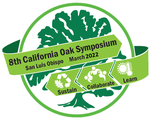#40

Identifying second order effects of fire on California oaks
Shane Dewees, Leander Anderegg, Max Moritz, Nicole Molinari
Fire can cause tree mortality both immediately, through large-scale tissue necrosis, and post-fire, through second order effects on the phloem and xylem. The extent of the occurrence of these second order effects is largely believed to be driven by fire intensity. As climate change continues to worsen and is causing more frequent and intense fires, understanding the extent to which these second order effects occur in a tree and how they affect tree health is of growing importance. Our preliminary work on Quercus kelloggii (Black oak), a culturally and ecologically important oak species, reveals that a relatively low intensity surface fire can cause full depth cambium necrosis in the bark. Additionally, we identified heat-plume induced leaf embolism, which caused a significant reduction in leaf specific conductivity. Considerable variation in the degree of damage was observed, however. Therefore, future work will be focused on better understanding the determining factors of the extent of post-fire damage and investigating the affects that damage has on whole tree health.
